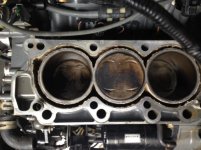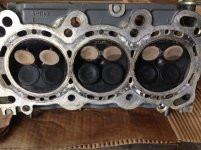Agree that the port engine looks fine on a cold compression test.
IMO the starboard is crazy. It tells me that the valves are not seating properly. There can be several causes - cam wear, cam bushings, or cam out of alignment. Or valves burnt, scored, or bent. The other possibility is a cracked head, but that is extremely rare on a Honda. Any way you look at it, you are going to need to pull the heads and have them micro-flux'ed and refurbished. Also have the cam mic'ed out to be sure it is in spec. That will also give you the opportunity to inspect the cylinder sleeves and piston heads in detail.
IMO the starboard is crazy. It tells me that the valves are not seating properly. There can be several causes - cam wear, cam bushings, or cam out of alignment. Or valves burnt, scored, or bent. The other possibility is a cracked head, but that is extremely rare on a Honda. Any way you look at it, you are going to need to pull the heads and have them micro-flux'ed and refurbished. Also have the cam mic'ed out to be sure it is in spec. That will also give you the opportunity to inspect the cylinder sleeves and piston heads in detail.



